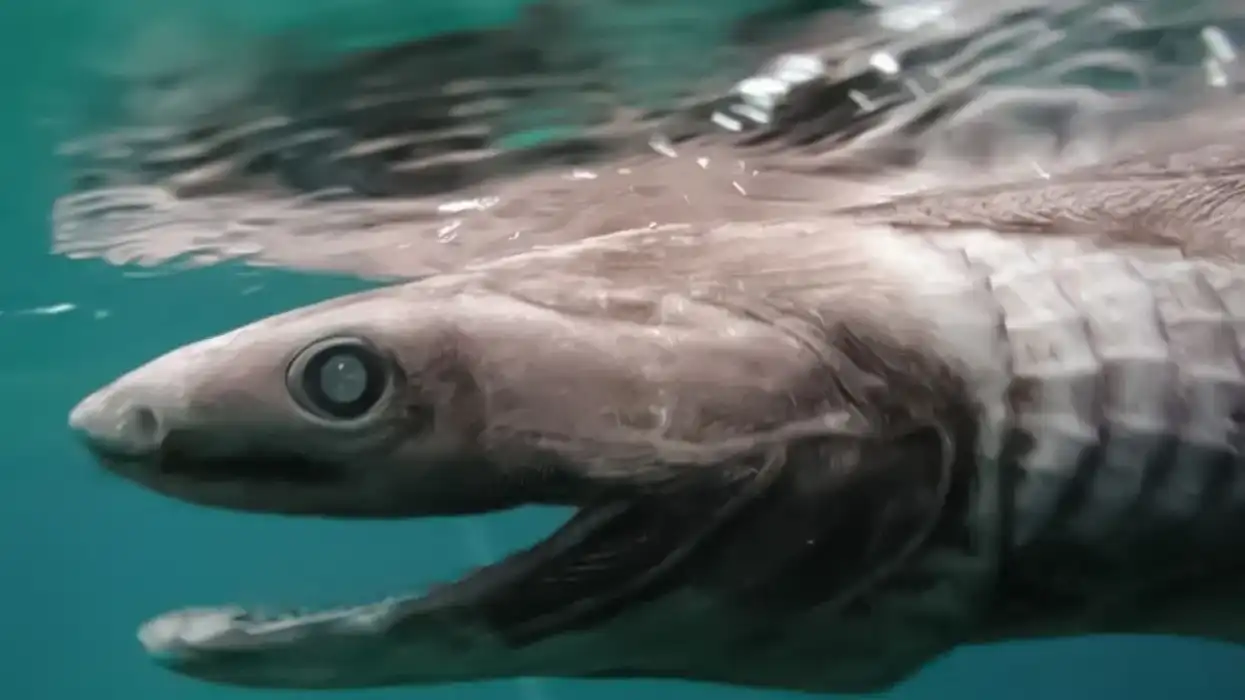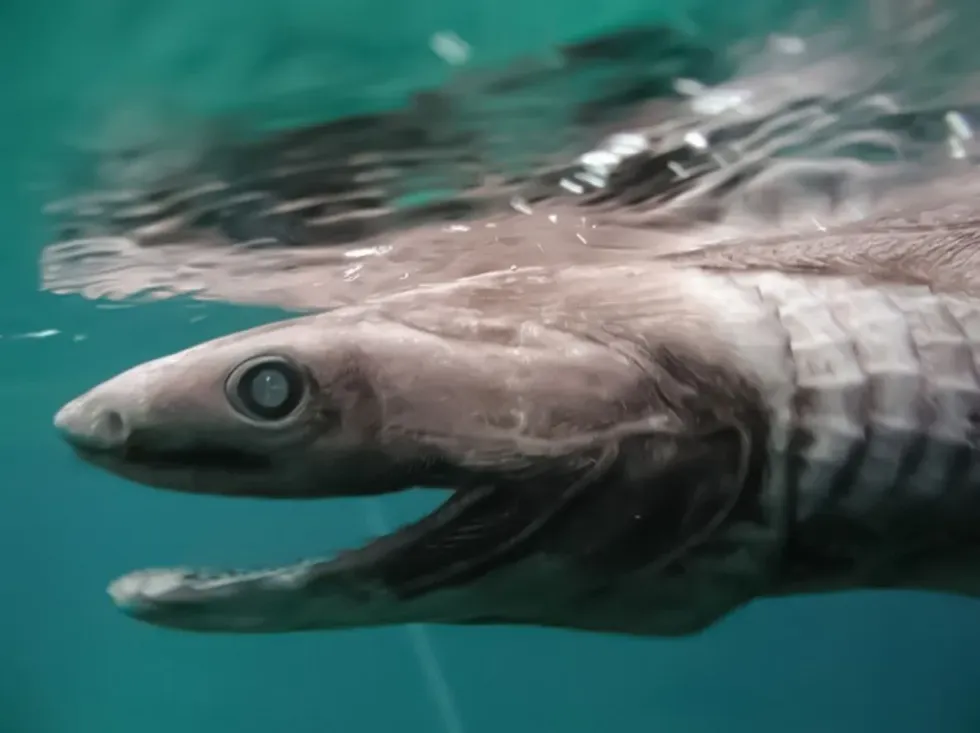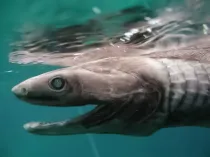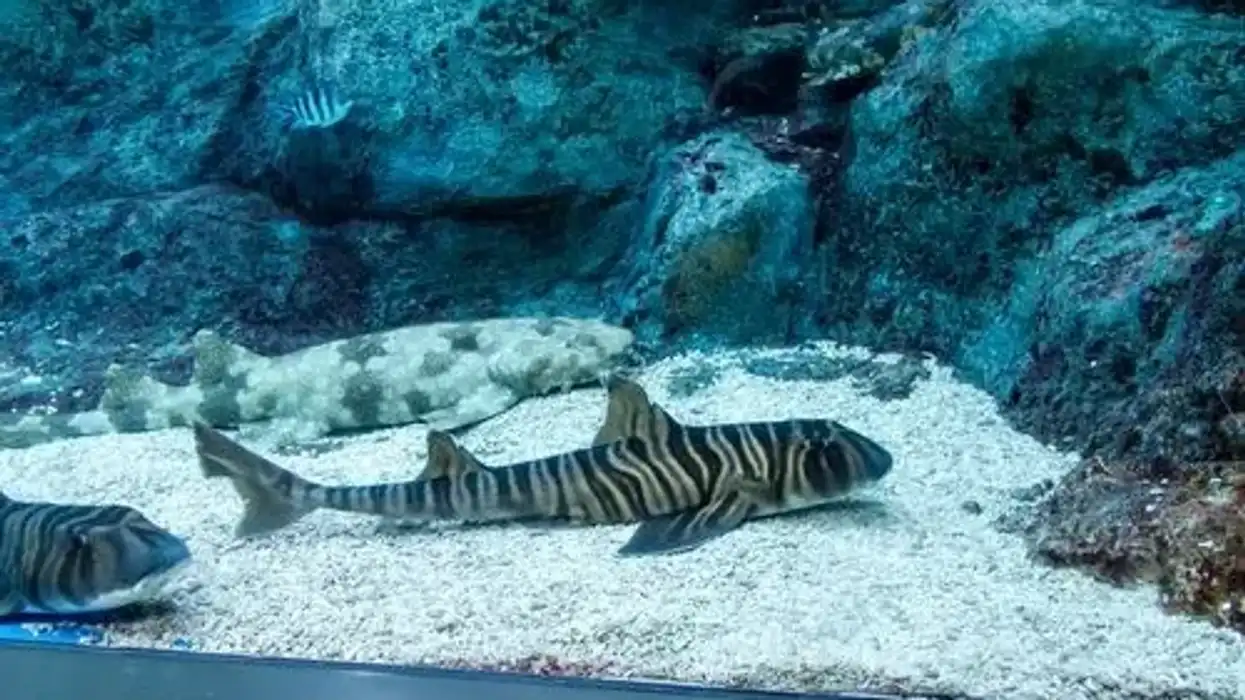Fun Frilled Shark Facts For Kids
Content
- What type of animal is a frilled shark?
- What class of animal does a frilled shark belong to?
- How many frilled sharks are there in the world?
- Where does a frilled shark live?
- What is a frilled shark's habitat?
- Who do frilled sharks live with?
- How long does a frilled shark live?
- How do they reproduce?
- What is their conservation status?
- What do frilled shark look like?
- How cute are they?
- How do they communicate?
- How big is a frilled shark?
- How fast can a frilled shark swim?
- How much does a frilled shark weigh?
- What are their male and female names of the species?
- What would you call a baby frilled shark?
- What do they eat?
- Are they dangerous?
- Would they make a good pet?
- Did you know...
- How many teeth does a frilled shark have?
- How old is the frilled shark species?
Get ready to know all you can about the frilled shark (Chlamydoselachus anguineus) one of the oldest surviving members of the shark species. The frilled shark's fossil records date back to 95 million years ago and maybe even 300 million years ago.
Very little was known about this deep water shark species until August 2004, when a camera managed to capture the frilled shark in its natural habitat off the coast of southeastern USA.
The eel like frilled shark (Chlamydoselachus anguineus) has primitive features with rough, dark brown skin. Six pairs of gill slits are found along the throat of the snake like frilled shark. Their gills create a frilly appearance which gives rise to the frilled shark name. They are also known as 'living fossil' due to their primitive features.
They can be found on outer continental shelves and are deep sea inhabitants. Frilled sharks tend to swim at depths of 1,000 meters (3,300 feet). The snake like frilled shark (Chlamydoselachus anguineus) prefers to lay at the bottom of the ocean, rarely coming to the surface.
Read on to find out more frilled shark facts. For more interesting animal facts, check out our articles on Grey Reef Shark and Porbeagle Shark.
Frilled Shark Interesting Facts
What type of animal is a frilled shark?
The frilled shark is a type of deep sea shark fish that belongs to the Chlamydoselachidae family species. Its common name is frilled shark, its scientific name is Chlamydoselachus anguineus and it belongs to the genus Chlamydoselachus. Frilled sharks are among the oldest species of sharks and are referred to as 'living fossil' due to their primitive features.
What class of animal does a frilled shark belong to?
Frilled sharks belong to the class Chondrichthyes of the Animalia kingdom. Their Phylum is Chordata, order is Hexanchiformes, family is Chlamydoselachidae, and genus is Chlamydoselachus.
How many frilled sharks are there in the world?
Because the frilled shark was only spotted in August 2004, there is no global population estimate for the frilled sharks of the world.
Another factor that makes it difficult to accurately arrive at a population estimate for this species is the fact that they live at the bottom of the ocean in different patches of the Atlantic Ocean and Pacific Ocean.
Research is still being carried out to understand the population trends of this shark species.
Where does a frilled shark live?
Frilled sharks live in the deep water of the Atlantic, Pacific, and Indian Ocean. Their distribution is wide. Frilled sharks can be found in lesser depths at Suruga Bay, Japan.
Between August and November though when the temperatures rise, they swim into deeper, cooler water. In the eastern Atlantic Ocean, they can be found in the deep water of Norway, Scotland, and Ireland. In the western Atlantic Ocean, they inhabit the deep water of New England, Georgia, and Suriname.
In the western Pacific Ocean, they inhabit the regions from Japan to Australia and New Zealand. In the central as well as the eastern Pacific Ocean, they inhabit the deep water of Hawaii, California, and Chile. They are also found in the western Indian Ocean near South Africa.
What is a frilled shark's habitat?
The frilled shark habitat typically includes the outer continental shelf water, the upper-middle continental slope, and other biologically flourishing areas. This species prefers a habitat in the deep sea in proximity to the ocean floor where temperatures are cool.
Frilled sharks are a benthic species and are usually found swimming at depths of 1,000 meters (3,300 feet). Frilled sharks usually don't swim deeper than 1,570 meters (5,150 feet).
Who do frilled sharks live with?
The frilled shark species is a solitary species. They rarely even interact with other frilled sharks.
Whether in New Zealand water or other regions of the world, the species can be found to practice spatial segregation. The unit of space that they occupy in their natural habitat is dependent on frilled shark size, reproductive health of the frilled shark, and the sex of frilled sharks present.
How long does a frilled shark live?
The natural lifespan of frilled sharks is difficult to determine as they are a rare species that is still being studied. They haven't ever been kept in captivity and because they live close to the ocean floor without scope for our direct observation, an accurate figure of their lifespan hasn't been computed.
However, researchers estimate that frilled sharks can live for up to 25 years.
How do they reproduce?
Frilled sharks don't have a specific breeding season because they live too deep in the sea for seasonal changes to affect them. These animals are ovoviviparous meaning that although they produce eggs, they don't lay them.
The egg yolk nourishes the embryos and eggs hatch inside the mother frilled shark's body before birth. It is also likely that the womb's gland secretions are used to nourish the embryo into a healthy pup.
The female frilled shark pregnancy, or gestation period, is one of the longest in the animal kingdom. Frilled sharks have a gestation period of 3.5 years. They can have anywhere between 2-15 pups, although the average number of pups is six.
Newborn frilled shark length is 40-60 cm (16-24 in) and their gills are fully developed at birth. Sexual maturity in these animals isn't determined by the number of years, it is determined based on their length of their body.
Male frilled sharks reach sexual maturity when their body grows to 1.0-1.2 meters (3.3 - 3.9 feet) in length. Female frilled sharks reach sexual maturity when their body grows to 1.3-1.5 meters (4.3-4.9 feet) in length.
What is their conservation status?
Frilled sharks were classified as Near Threatened by the International Union for the Conservation of Nature due to their long gestation period and slow rate of reproduction. In 2016 however, their conservation status was shifted to that of Least Concern. Considering frilled sharks are one of the oldest species around, this makes sense.
There are however, some factors that pose a threat to the frilled shark population. Commercial fishing tests pose one of the biggest threats, picking up any frilled sharks venturing close to the surface as by-catch of the fishing industry. When they're caught as by-catch, they are usually converted into fishmeal or sold as meat.
Pollution of the ocean, chemical spills, and oil spills can poison them or their prey. It can even cause migration of prey species seeking cleaner water. Such a migration of prey ultimately impacts the frilled shark's population as well.
Frilled Shark Fun Facts
What do frilled shark look like?

Frilled sharks have a long, slender dark brown colored body and a snake like appearance with rough skin. They have vertical slits for nostrils and a short, rounded snout.
They have relatively large pectoral fins, with the dorsal and anal fin located at the back of their body. They have six gills on either side of their body that meet at the front of their throat, giving them the appearance of a collar or a frilly appearance.
The appearance of their gills is the inspiration for their name. Their eyes are positioned on either side of their head and their lateral white line curves upward above their gills.
Covering the under portion of their bodies, frilled sharks have thick folds of skin, the function of which has not yet been identified. These sharks have long jaws with 300 trident shaped teeth in 25 rows of teeth. The upper jaw has 19–28 tooth rows while the lower jaw has 21–29 tooth rows.
How cute are they?
Cute isn't exactly the word you'd use for these eel-like animals, unless you're someone who loves sharks in general. Their short snout, backward facing, trident shaped 300 teeth that line into 25 rows, long jaws, and general snake line appearance makes them anything but cute.
How do they communicate?
Not much is known about the way that these sharks communicate because of the lack of opportunities to study them in detail. However, it is assumed that they tend to communicate much like other sharks using their sense of touch and lateral line.
It is likely that they can pick up on long distance vibrations, electrical pulses produced by animal muscles, and changes in water pressure. The ability to detect changes in water pressure allows them to perceive the difference between up and down.
They are also sensitive to sounds. The frilled shark adaptations over the years have kept it around for so long, making it one of the oldest sharks in existence.
How big is a frilled shark?
Sexual dimorphism is seen in frilled sharks with females being bigger than males. The average length for these male animals is 3.2 - 3.6 feet while the average length for females is 4.4 - 4.9 feet.
However, frilled sharks with a bigger body have also been identified. The maximum body length seen in males has been 5.6 feet (1.7 meters ) while the maximum body length seen in females has been 6.6 feet (2.0 meters). Their body grows rapidly once they are born and in open water.
How fast can a frilled shark swim?
These sharks swim weakly and are slow moving sharks. They have naturally buoyant bodies due to their large livers being filled with low density lipids. They make snake like movements in water, curling and coiling their bodies instead of swimming in a straight line.
How much does a frilled shark weigh?
Not much has been documented about the weight of these animals because of the lack of opportunities to study them. Injured, caught, sick, lost, or dead frilled sharks that have washed up to the surface of water are the only specimens to be researched.
Based on that, the average weight of the frilled shark seems to be 91 kg (200 lbs).
What are their male and female names of the species?
Much like other sharks, frilled sharks don't have specific names for males and females of the species. They are just called frilled sharks, regardless of whether they are male or female.
What would you call a baby frilled shark?
Like the baby of other sharks, frilled shark babies are referred to as pups and there can be anywhere between 2-15 pups in one instance of pregnancy, although the average number of pups is usually six.
What do they eat?
Based on the stomach contents of frilled shark that have been found, it can be said that the frill shark diet consists mainly of squid, octopus, bony fish, and smaller sharks such as the Japanese catshark.
They are able to detect their prey with the help of vibrations sensed by their lateral lines, electrical pulses from animal muscles, and their strong sense of direction. To sustain their diet, they can sometimes practice diel vertical migration, where they move to the surface of the ocean at night to feed.
They return from the surface to the ocean's depths once they're done.
Scientists speculate that they hunt their prey in one of three ways: by curling their bodies to strike their prey like a snake, by creating negative pressure using their gill slits to suck prey into their mouth, or by using their bright white teeth to lure their prey before catching them.
Are they dangerous?
Because humans rarely come in contact with them, there is no risk of frilled shark attacks. Even ones that have washed up on shore haven't been aggressive towards humans. The frilled shark bite and other cuts that scientists have received by their teeth when trying to study them are about as dangerous as they get.
Would they make a good pet?
Frilled sharks are wild animals and would not make good pets. They naturally live in the depths of oceans in environments that cannot be recreated for pets.
Did you know...
The frilled shark was discovered by a German scientist named Ludwig Doderlein in Japan between 1879 and 1881. Ludwig Doderlein maintained a manuscript of his observations about this nameless species, but it was lost. In 1884, Samuel Garman, an American scientist, published his own findings and is therefore credited with having discovered and named the shark.
Until 2009, it was believed that only one variety of frilled shark exists. That changed when the Southern African frilled shark, a related species, was captured off the Namibian coast. The scientific name for this frilled shark species is Chlamydoselachus africana. The Chlamydoselachus africana frilled shark has longer gill slits and longer pectoral fins than the Chlamydoselachus anguineus.
It is also called frill shark, scaffold shark, or lizard shark.
How many teeth does a frilled shark have?
Frilled shark teeth are fascinating. They have long jaws with 300 teeth in 25 rows. The upper jaw has 19–28 tooth rows while the lower jaw has 21–29 tooth rows. Their teeth help them to hold their prey and even lure in unsuspecting animals by acting as a beacon.
How old is the frilled shark species?
The frilled shark's fossil records date back to 95 million years ago and maybe even 300 million years ago. Although some believe that its lineage can be traced back to the Carboniferous period and Palaeozoic era, discoveries relating to the fossilized teeth of the shark can be traced to the early Pleistocene epoch (2.58–11.70 mya).
Here at Kidadl, we have carefully created lots of interesting family-friendly animal facts for everyone to discover! Learn more about some other fish including zebra shark, or Caribbean reef shark.
You can even occupy yourself at home by drawing one on our frilled shark coloring pages.
We Want Your Photos!
More for You
See All
Bachelor of Arts specializing in English Literature

Akinwalere OlaleyeBachelor of Arts specializing in English Literature
As a highly motivated, detail-oriented, and energetic individual, Olaleye's expertise lies in administrative and management operations. With extensive knowledge as an Editor and Communications Analyst, Olaleye excels in editing, writing, and media relations. Her commitment to upholding professional ethics and driving organizational growth sets her apart. She has a bachelor's degree in English Literature from the University of Benin, Edo State.
Disclaimer
1) Kidadl is independent and to make our service free to you the reader we are supported by advertising. We hope you love our recommendations for products and services! What we suggest is selected independently by the Kidadl team. If you purchase using the Buy Now button we may earn a small commission. This does not influence our choices. Prices are correct and items are available at the time the article was published but we cannot guarantee that on the time of reading. Please note that Kidadl is a participant in the Amazon Services LLC Associates Program, an affiliate advertising program designed to provide a means for sites to earn advertising fees by advertising and linking to Amazon. We also link to other websites, but are not responsible for their content.
2) At Kidadl, we strive to recommend the very best activities and events. We will always aim to give you accurate information at the date of publication - however, information does change, so it’s important you do your own research, double-check and make the decision that is right for your family. We recognise that not all activities and ideas are appropriate for all children and families or in all circumstances. Our recommended activities are based on age but these are a guide. We recommend that these ideas are used as inspiration, that ideas are undertaken with appropriate adult supervision, and that each adult uses their own discretion and knowledge of their children to consider the safety and suitability. Kidadl cannot accept liability for the execution of these ideas, and parental supervision is advised at all times, as safety is paramount. Anyone using the information provided by Kidadl does so at their own risk and we can not accept liability if things go wrong.
3) Because we are an educational resource, we have quotes and facts about a range of historical and modern figures. We do not endorse the actions of or rhetoric of all the people included in these collections, but we think they are important for growing minds to learn about under the guidance of parents or guardians.







